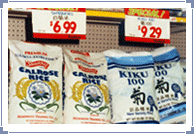In 1945, the end of World War II ushered in an era of unprecedented changes in Japan-U.S. foodstuff trade. During this time, Japanese commerce was finally reintegrating with the global trading community as Japanese demand grew for more and increasingly diverse foods and food products.
After the war, the time was ripe for the Nishimoto General Store to re-embark under the new name, the Nishimoto Trading Co. Ltd. With the Company’s new name, we returned to our position as a front runner in Japan-U.S. trade, including trade with the islands of then U.S.-ruled Okinawa, of Southern Japan, and introduced the people of Japan to a variety of foods from the U.S. even greater than what had been available pre-war. In this regard, the Company was able to significantly contribute to the internationalization of the Japanese diet of the era.
At the start of the 1950s, the Company re-entered the U.S. market, establishing a local corporation in Los Angeles to act as a base to purchase U.S. goods and to sell Japanese food products. This move positioned us as the first Japanese trading company to re-enter the U.S. and manifested our re-found resolve.
It was also around this time that we laid the foundations of our California-based rice cultivation and distribution operations. Today, California rice lies at the root of our business growth; the success of which reflects our determination and inspires yet another source of pride within the Company.

- 拡大
- U.S. shoppers purchasing rice

- 拡大
- Rice featured on U.S. supermarket shelves of the era

- 拡大
- Sunkist head office
Throughout Japan's period of rapid post-war economic growth, we forged ahead acting as an importer of U.S. citrus fruits. Nishimoto Trading Co. became the sole sales agent for Sunkist Growers, Inc., and our sales grew as we succeeded in making U.S. lemons, oranges, and grapefruits, all luxury goods at the time in Japan, an integral part of meals in the average Japanese home. Also, during that time, growing numbers of Japanese companies were establishing operations in the U.S., stirring a corresponding increase in the consumption of Japanese foods. To meet that demand, we proceeded to establish more branches, first in Hawaii, then New York, and later San Francisco.

